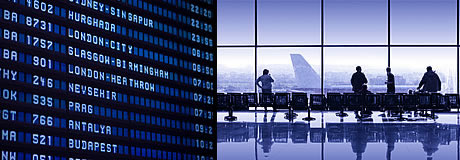E-travel: flying into the future

Fed up of queuing for hours just to check yourself in at the airport? You won't have to fret for much longer as the world's airlines gear up to go completely electronic by 2008 – a shift that will have major implications for both carriers and passengers. But what exactly will this move involve?
No more paper tickets?
For a start, instead of traipsing to the local travel agent to get those coveted airline tickets, most travellers can now enter the world of e-ticketing. This allows passengers to book their flights over the web and store their details in an e-ticket held by their airline - eliminating the painful process of only realising upon arrival at the airport that the important slips of paper are back at home on the kitchen table.
Of course in this day and age, the benefits of such a practice extend beyond mere convenience. Unlike their paper counterparts, these tickets cannot be stolen and reused by someone else, as the information can only be accessed by authorised staff. In addition, some tickets can be easily updated should any changes be made to the journey and tickets can be received by post.
Facts and figures
The service has come a long way since it was first introduced over ten years ago. The search for an easier way to do business began when technology firm Sita met with executives from British Midland Airways (otherwise known as bmi) in 1995 to consider ways of using the internet for travel purposes - at a time when worldwide web users numbered in their tens of millions rather than today's billion-plus figure.
Western airlines quickly took to e-ticketing, but left their Asian and Middle Eastern counterparts trailing in their wake. However, they soon picked up speed and recent years have seen a number of eastern airlines announce their first electronic offerings.
American Airlines became the first carrier to introduce full interline e-ticketing with other members of the oneworld alliance in 2003 and the entire practice has been increasingly refined and taken up by other airlines ever since.
Sita's latest Annual Airline IT Trends Survey indicates that more airlines than ever are turning to e-ticketing, with 59 per cent of all carriers providing the service and with the International Air Transport Association (IATA) recently celebrating the passage of a deadline obligating member airlines to roll out 100 per cent e-ticketing across their networks.
What else is happening?
Online check-in is another way in which airlines are harnessing technology to benefit customers. While e-tickets form an integral part of the booking process, the actual procedure of arriving at the airport and getting on a flight has been made much quicker through alternative check-in methods.
A number of airlines offer online check-in as part of an effort to make the process more efficient. This involves the passenger being able to log onto the airline's website and print off their own boarding pass. The benefits to the customer are numerous; they can select the seat they want for the flight in advance and then go straight to the baggage drop-off point at the airport, bypassing the long queues and general stress now synonymous with airport check-in.
While the time period within which customers can pre-select their seat varies from airline to airline, as a general rule of thumb most passengers should be able to do so from a minute past midnight on the day of the flight. Savvy travellers making good use of websites such as Seatguru.com will be able to bag the best seat with the most leg room and a window first.
So how many airlines are offering this tempting service? According to the Sita survey, 42 per cent of carriers are providing online check-in. If you tap 'online check-in' into any search engine most of the results point to airlines' own websites - proof that the service is being taken seriously by many.
Anything else?
The IATA has been relentless in its push to modernise the way airlines deal with passengers and has kickstarted a complete e-revolution within the industry. Part of this is its Simplifying the Business initiative, which, as well as e-ticketing, comprises the complete use of self-service check-in kiosks at airports, barcodes for boarding passes and electronic baggage management.
Numerous other initiatives have flowered within the industry since the first online flight service back in 1995. Nowadays, select passengers - usually those flying first or business class - can go through fast-track security procedures involving biometric identification and other technologies that are as accurate as they are speedy.
Another important part of the general embrace of the online world is e-passports. These are normal passports with a small chip implant in the back cover. This chip contains the same data displayed in the passport itself and also has an additional digital photo for biometric identification purposes. These e-passports are primarily set to be rolled out in certain countries only, although it may be inevitable that other countries follow them down the same path.
It all sounds too newfangled for me...
These concepts may sound a tad technical for the average layman. However, now that most airlines have begun implementing services such as e-ticketing and online check-in, travellers choosing to fly abroad will have no option but to embrace them too. With talk of more airports charging passengers to go through the physical check-in procedure and even scrapping check-in desks altogether, holidaymakers had better take to these services as soon as possible - or risk losing out.